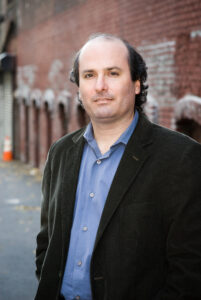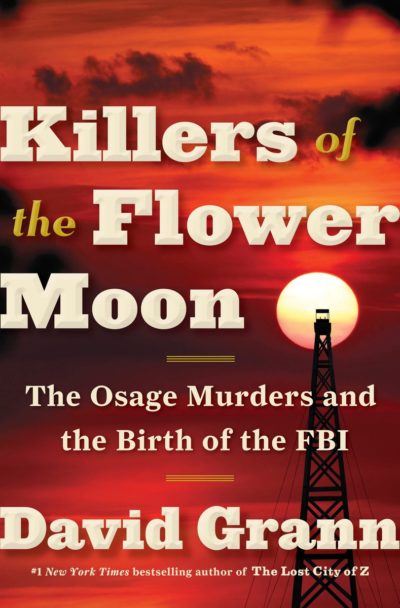Sometimes the idea for a book springs from what you don’t know.
David Grann had never heard of the “Osage Murders” until a historian he was talking to mentioned the series of mysterious deaths among members of the wealthy Osage tribe in early 20th century Oklahoma.
Grann, a staff writer at The New Yorker and something of a history writer himself, couldn’t believe that the sinister campaign targeting the oil beneath the Osage reservation land was so little known. So he started looking into the killings.
When I learned about these crimes several years ago, I was shocked that, like so many Americans, I had never learned about them in school or read about them in books.
There wasn’t much online. No one seemed to have told the victims’ story in a comprehensive way, even though, as Grann puts it, the campaign was “one of the most monstrous crimes in American history.”
He started sending off requests to places where documents about the murders might be stored. Slowly they arrived and began to pile up in the corner of his office. When he finally looked through them, he could see they told an epic story of racial injustice and greed, in which white settlers positioned themselves to inherit mineral rights from tribe members, whom they then killed.
Grann got on a plane to Tulsa and drove out to Pawhuska, where he found the Osage Nation Museum. There he stood in front of a 1924 photo of the entire tribe gathered with white settlers. But oddly, a piece of the photo that had been cut out. When he asked the museum director about it, she pointed to the blank space and said, “The devil was standing right there.”
Grann knew then he had to write the book that became “Killers of the Flower Moon," published this month.
I asked him a few questions about the process.

Both “Killers of the Flower Moon” and your previous book, “The Lost City of Z,” [about the explorer Percy Fawcett, who disappeared in the Amazon in 1925] are historical narratives mixed with some first person, but they’re also different kinds of stories. Do you see them as having anything in common?
Both books have some element of intrigue. “The Lost City of Z” probes a great exploration mystery of the 20th century, and in “Killers of the Flower Moon,” I try to peel back the layers of a murder mystery. But, in most respects, they are very different—in subject matter, worlds and narrative structure. Every time I start a new project, I want to be investigating something new, with its own set of challenges and rewards.
You’ve said there are three things you need to write a book. What are those things?
I haven’t done enough books to have any fixed rules. But at least with “The Lost City of Z” and “Killers of the Flower Moon” I looked for at least three crucial elements before beginning. The first is the most obvious but also the hardest to find—and that is a story worth telling. Is the subject matter gripping? Are the people involved interesting? Are there things to discover along the way? I also want to make sure the story is about something larger than just the particulars. “The Lost City of Z” is a tale of adventure, but it is also fundamentally about whether an ancient civilization could exist in the Amazon and how such a discovery would transform our understanding of what the Americas looked like before the arrival of Christopher Columbus. “Killers of the Flower Moon” is a crime story with many twists and turns, but ultimately it’s about a grave racial injustice and about the formation of the United States as a country.
The second critical element I look for is whether there is enough source material. As a nonfiction writer, there are lots of stories I would love to tell, but I often can’t because there’s simply not enough living sources or historical records. In the case of “Killers of the Flower Moon,” I spent months trying to assess what source material existed. I sent letters to courthouses and police departments. Using the Freedom of Information Act, I filed requests for documents with the FBI and other government agencies. While I was waiting for a response, I worked on other stories at The New Yorker. As materials began to trickle in, I would put them in the corner of my office and not even glance at them. Finally, after nearly a year, I began to comb through these materials. They were only a fraction of what I would need to write the book, but they gave me the confidence to commit to the project, which would take me nearly another four years to complete.
The final element that went into my decision to do a book is less rational. It’s whether, at some emotional level, I feel compelled to tell this story. I know how long books take, and if I don’t feel that need—indeed, even a compulsion—I’ll lose my mind and undoubtedly write a terrible book.
One of the challenges of writing historical (or any) nonfiction is finding a solid narrative thread. For this book, you had almost endless characters and murders to choose from. How did you know when you’d found the right ones for the book?
You asked me about the three things I generally need to do a book. In the case of “Killers of the Flower Moon,” there was a fourth element that was essential, which was coming up with a structure. Early on, I had no idea how to tell the story; it spanned so many years and there were so many characters and investigations, I was overwhelmed. And what I didn’t want to do is just write a book cataloguing the dead. I wanted to make sure that there was a deep sense of who these people were, how they lived, how they felt. And it was only when I resolved the structure—telling the story in three separate chronicles, each largely from a different individual’s perspective—that I felt that I could concentrate on the material and write the book.
The first chronicle is told largely from the perspective of an Osage woman named Mollie Burkhart, whose family had become a prime target of the murder conspiracy. The second chronicle is told from the perspective of one of the investigators. And the third chronicle is told from my perspective in the present. This structure also allowed me to deepen one of the themes of the book, which is that each of us are often only able to glimpse part of history as it is unfolding; only with time does a fuller portrait emerge, and even then, there are parts that elude us.
Some of the most valuable material for this book you found by going to archives yourself, and by being in Osage County talking to people—good old-fashioned reporting. Do you have any thoughts on the value of real-world reporting, versus online reporting, for writers these days?
Research online can help you identify possible archives or people involved in a story. But then I always try to meet with people involved and visit the archives that might contain documents. I find you get so much more information that way. When I was researching “Killers of the Flower Moon,” I spent weeks visiting a branch of the National Archives, in Texas. Each day, I would pull boxes that I thought might contain materials related to the case. Much of the time I turned up nothing of interest and was miserably bored, and then suddenly I would open a box and discover something revelatory. One time I found the secret grand jury testimony from many of the murder cases, which was not identified in a catalogue and I didn’t even know existed. During the research for the book, I also tried to find descendants of both the victims and the murderers. These sources were critical in allowing me not only to learn more about what happened in the past, but also to understand how this history still played out in the present.
The final element that went into my decision to do a book is less rational. It’s whether, at some emotional level, I feel compelled to tell this story. I know how long books take, and if I don’t feel that need—indeed, even a compulsion—I’ll lose my mind and undoubtedly write a terrible book.
You say there was “a culture of systematic murder” in Osage County during what the Osage call the “Reign of Terror.” When did that become apparent?
Before long, I got some hints of it from the Osage I spoke to. I also read Dennis McAuliffe’s excellent memoir, “The Deaths of Sybil Bolton,” which was published in 1994 and detailed his investigation into the mysterious death of his Osage grandmother. He documents how she, too, was murdered for her oil money during the Reign of Terror. Yet her case had never been probed by the FBI or been included in the official tally of murders. So early on I knew there were additional leads I needed to pursue. But it was only over many years, as I spoke to descendants of previously unknown victims and pored over archival materials, that I had sense of the breadth of this systematic campaign of murder.
Do you have any thoughts on why this dark chapter in American history was forgotten in the larger (non-Native) American culture?
When I learned about these crimes several years ago, I was shocked that, like so many Americans, I had never learned about them in school or read about them in books. After the FBI’s investigation, in the 1920s, the crimes—or at least some of them—were well known. But over time they faded from the headlines. And I think that, just as many of the crimes were covered up because of racial prejudice, this chapter of history was neglected because of prejudice.
How do things stand today in Osage County, with regard to the Reign of Terror?
The Osage I spoke to still remember the victims and decorate their graves. Some of them still try to investigate unsolved cases to try identify the perpetrators. Unlike so many Americans, they cannot forget what transpired.



